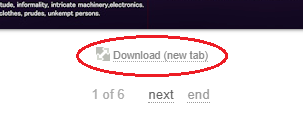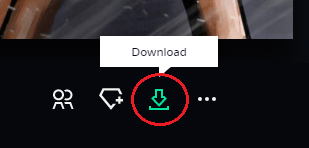CruFox 












inkbunny
Copy link from “Download (new tab)” that is under the image to get the best possible resolution

Tumblr
Below is a quote from this thread on Derpibooru that explains how to get the best files:
Furry Network
“Download” link is on the right side, under the artist name

e621
Always copy the url from “Download” button that is under the image:

Copying url from the picture itself might not provide the best possible resolution. When something like “Sample (800)” is displayed under the image then the image is lower than the original file available, don’t use those when uploading to Furbooru.
Derpiboru
Copy url from one of those. Technically you can also use “View” or “VS” but with SVG files using them will give you a PNG file instead of the SVG one.

Copying url from the picture itself might not provide the best possible resolution.
————
Updating/merging images on the site
If you want to replace an older low res/low quality image that is already present on Furbooru with it’s larger res/better quality version, upload the better version and then go to the worse image and report it for merging into the new, better one:

ID of the image is the value from image url that is after
Moderator
I like tags
This thread is meant to gather information about accessing best possible quality and resolution of images from various sites so that they can be uploaded to Furbooru.
Firstly, when possible always upload images from a file that is from the artist’s gallery. Note that sometimes artists upload their work on e621 or Derpibooru themselves and you might even find the best quality there instead of their other profiles.
If you stumble upon some low res image on the Internet it is always best to reverse search for the original submission.
You can do it using Google Images reverse search (https://www.google.com/imghp ):

and if this didn’t help then you can try those:
https://saucenao.com/ - general art, including furry or MLP.
https://kheina.com/ - 40% of Fur Affinty and entire Furry Network indexed
https://derpibooru.org/search/reverse - for MLP themed images only
If you are using Telegram you can try this bot: @FindFurryPicBot
Secondly, fetch the image from a proper url. Exact way to do that is dependent on the site, details are explained below.
Generally it’s best to always use urls copied from download links and not from clicking on image itself, because images can be displayed only as a medium or low res preview instead of the original size.
Fur Affinity
Fur Affinity automatically resizes all images at first upload to be no more than 1280px in height or width. This can be circumvented by the uploader by using the “Change submission file” option, but most artist don’t do that. That means that when file on FA is only 1280 px there is a possibility that a larger version of that image exist on some other site where the artist posts their work, for example on Twitter or dA, it is worth checking there.
Nevertheless, to get the best possible resolution from FA right click on “Download” and copy that link to Furbooru url fetch.

Classic theme

Modern theme
Copying image url from image itself instead of that Download link will result in a low res image if the image is not opened at full size. It’s best to always copy image url from Download link. Correct link will start with
Twitter
Images from Twitter are fetched by Furbooru from the post url automatically in the best possible quality. Be wary not to fetch small images from direct urls because you might not get the best possible resolution or get a JPG file instead of PNG ones. Always use post url (starting with
If for some reason fetching from post url is not working and you have to do it from direct link then read this appendix to learn how to get the best file then.
Deviantart
Sometimes image fetched from post url can be of lower resolution then what can be downloaded. Sadly images from dA can’t be fetched from download link, they have to be downloaded and then uploaded to Furbooru as files.

If there is no download link, then, as explained in this Derpibooru thread:
Firstly, when possible always upload images from a file that is from the artist’s gallery. Note that sometimes artists upload their work on e621 or Derpibooru themselves and you might even find the best quality there instead of their other profiles.
If you stumble upon some low res image on the Internet it is always best to reverse search for the original submission.
You can do it using Google Images reverse search (https://www.google.com/imghp ):
and if this didn’t help then you can try those:
https://saucenao.com/ - general art, including furry or MLP.
https://kheina.com/ - 40% of Fur Affinty and entire Furry Network indexed
https://derpibooru.org/search/reverse - for MLP themed images only
If you are using Telegram you can try this bot: @FindFurryPicBot
Secondly, fetch the image from a proper url. Exact way to do that is dependent on the site, details are explained below.
Generally it’s best to always use urls copied from download links and not from clicking on image itself, because images can be displayed only as a medium or low res preview instead of the original size.
Fur Affinity
Fur Affinity automatically resizes all images at first upload to be no more than 1280px in height or width. This can be circumvented by the uploader by using the “Change submission file” option, but most artist don’t do that. That means that when file on FA is only 1280 px there is a possibility that a larger version of that image exist on some other site where the artist posts their work, for example on Twitter or dA, it is worth checking there.
Nevertheless, to get the best possible resolution from FA right click on “Download” and copy that link to Furbooru url fetch.
Classic theme
Modern theme
Copying image url from image itself instead of that Download link will result in a low res image if the image is not opened at full size. It’s best to always copy image url from Download link. Correct link will start with
d.facdn.netImages from Twitter are fetched by Furbooru from the post url automatically in the best possible quality. Be wary not to fetch small images from direct urls because you might not get the best possible resolution or get a JPG file instead of PNG ones. Always use post url (starting with
twitter.com/) and not direct links (starting with pbs.twimg.com/) for fetching.If for some reason fetching from post url is not working and you have to do it from direct link then read this appendix to learn how to get the best file then.
Deviantart
Sometimes image fetched from post url can be of lower resolution then what can be downloaded. Sadly images from dA can’t be fetched from download link, they have to be downloaded and then uploaded to Furbooru as files.
If there is no download link, then, as explained in this Derpibooru thread:
Valid for images, uploaded BEFORE April 2019
Since recent changes, DeviantArt may provide preview with this kind of link:
https://images-wixmp-ed30a86b8c4ca887773594c2.wixmp.com/f/88ebff53-5056-4201-8dee-c401538f67b1/dctnmkq-66863252-a298-4253-8acf-457fb3093b19.jpg/v1/fill/w_1280,h_915,q_70,strp/when_it_strikes____by_backlash91_dctnmkq-fullview.jpg?token=eyJ0eXAiOiJKV…
You may cut everything starting from/v1/fill...(and add/intermediarybefore/f/) to retrieve bigger image:
https://images-wixmp-ed30a86b8c4ca887773594c2.wixmp.com/intermediary/f/88ebff53-5056-4201-8dee-c401538f67b1/dctnmkq-66863252-a298-4253-8acf-457fb3093b19.jpg
They are still not original size, but larger anyway.For images, uploaded AFTER April 2019
Hash explicitly states which maximum resolution can be provided (and it probably can even expire). The only thing you can do - request PNG version, if DA shows JPEG. Change second file extension to png:
https://images-wixmp-ed30a86b8c4ca887773594c2.wixmp.com/f/66db0640-a284-40dd-8587-7ea23d755081/dd8xh3i-1ec5b8ca-3740-4d84-86b5-31ad71f2391c.png/v1/fill/w_1024,h_732,q_80,strp/_commission__secret_squirrel_admirer_by_kingkero_dd8xh3i-fullview.jpg?token=eyJ0eXAiOiJKV… -> https://images-wixmp-ed30a86b8c4ca887773594c2.wixmp.com/f/66db0640-a284-40dd-8587-7ea23d755081/dd8xh3i-1ec5b8ca-3740-4d84-86b5-31ad71f2391c.png/v1/fill/w_1024,h_732,q_80,strp/_commission__secret_squirrel_admirer_by_kingkero_dd8xh3i-fullview.png?token=eyJ0eXAiOiJKV…
inkbunny
Copy link from “Download (new tab)” that is under the image to get the best possible resolution
Tumblr
Below is a quote from this thread on Derpibooru that explains how to get the best files:
Valid for images, uploaded AFTER 2019 with new URL schema
Image link should be like following:
https://`NUMBER`.media.tumblr.com/`HASH`/`HASH`/s__`WIDTH`x`HEIGHT`__/`HASH`.`EXT`
For example
https://66.media.tumblr.com/05770dfe01305e4800e95b3ccafb2e9a/f964ad2be51306a6-4a/s2048x3072/333055a666b1612877b25addf97fe80823040ebd.png — it may open page with image.
Change sizes to something very big
https://66.media.tumblr.com/05770dfe01305e4800e95b3ccafb2e9a/f964ad2be51306a6-4a/s20480x30720/333055a666b1612877b25addf97fe80823040ebd.png — image on the page should be original size.Universal
You need to reblog posts, images from which you’re willing to obtain, and then request archive of your entire blog in settings. When it’s done, it will contain original images.
Furry Network
“Download” link is on the right side, under the artist name
e621
Always copy the url from “Download” button that is under the image:
Copying url from the picture itself might not provide the best possible resolution. When something like “Sample (800)” is displayed under the image then the image is lower than the original file available, don’t use those when uploading to Furbooru.
Derpiboru
Copy url from one of those. Technically you can also use “View” or “VS” but with SVG files using them will give you a PNG file instead of the SVG one.
Copying url from the picture itself might not provide the best possible resolution.
————
Updating/merging images on the site
If you want to replace an older low res/low quality image that is already present on Furbooru with it’s larger res/better quality version, upload the better version and then go to the worse image and report it for merging into the new, better one:
ID of the image is the value from image url that is after
/images/